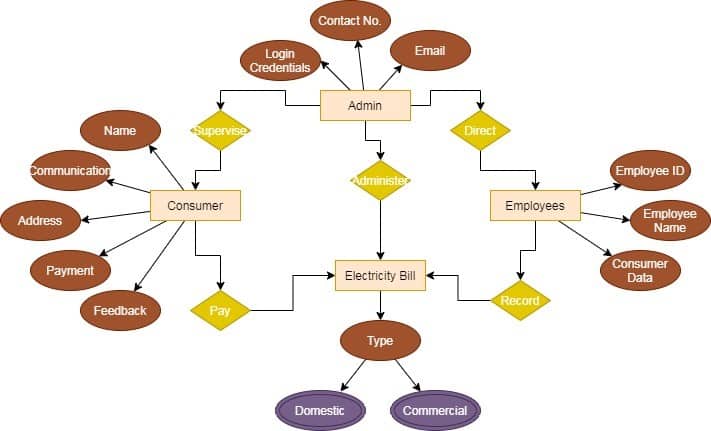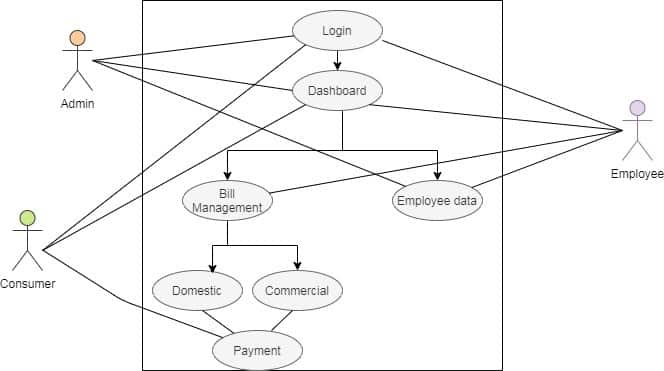Current System:
In current scenario the electricity personnel goes to each premises to note down the readings of the meters and then after receiving the data the board employees than calculate the used units amount and then send a printed electricity bill to be distributed by the electricity board personnel at every doorstep. After that, the consumer as per the last date of the bill goes to the electricity board office and pays the amount at the counter.
This system is hectic as the whole work is to be done manually and every month, sometimes due to any error the readings to be noted down are mendaciously calculated which requires a staunch process of investigation and it will be concluded in many days. Also there are chances of corruption in the process because all the work is delegated to different people and there’s no coordination among the people.
The process is also very lousy for the consumer also he needs to visit the office every month before due date and many times he forgets the due date and pays the extra amount as penalty and if a consumer wants to repine for mishap then it will be addressed by delaying the process which will goes on without any result or conclusion till then the consumer suffers. The process has become obsolete and needed to be automated.
Some salient points which are addressed as:
- The system is totally depends on the paper and manual work done by the employees and bill delivery personnel.
- The chances of error are very high because in paperwork it requires staunch and extensive care to protect the papers
- The consumer physically goes to the office to pay the bill every month and if he forgets then he is to be charged extra amount as penalty.
- The employees have to manage the data of every consumer current as well as the history of payment done by the consumer.
- The process is very time constraining and costly, requires extra hands to complete a work
Looking For Electricity Bill Management System? You can get-
- Electricity Bill Management System in C/C++
- Online Electricity Bill Management System in Java
- Electricity Bill Management System in PHP
- Electricity Bill Management System in Python for Final Year Student
- Electricity Bill Management System Database Project
- Report on Electricity Bill Management System
- Electricity Bill Management System Using Data Structure.
Proposed system of Elecricity Bill Management System
The whole world is shifting from manual to automated, in every sector the technology is gaining the access and automating all the functions of every industry and companies. This system is designed keeping in consideration the desideratum of employees, consumers and the admin withal. In this system the admin is the head ascendancy who regulated and manage the whole system, it has access to control the accounts of every consumer and employees as well. Now the system also contains a database of the employees and their circadian work. The admin keeps an ocular perceiver on every detail and modifies wherever required. Now the employees can access the account of consumers to calculate the readings and other work, but they don’t have access to open the account of any other employees.
Similarly, the consumer has access to open and manage his account but he cannot open the account of any other consumer, but the admin is the head entity, he can access anyone’s account. The system provides felicitous reading of the consumer and gives him option to pay the bill online. The system also send a vigilant before due date to the consumer to remind him.
Key features of this system are:
- The system reduces the physical work of the employees and provides a full support throughout the process of bill management
- Admin can update and change the record of the data feed by the employees into the system.
- Employees can track any irregularities which are complained by the consumer
- It provides online payment option to the consumer so that he doesn’t need to go electricity board for bill payment.
SOFTWARE REQUIREMENTS
HARDWARE REQUIREMENTS
Entity Relation Model

Elaboration:
The electricity bill management system is a revolutionary system which manages all the activities of the electricity board. This model shows the cognation among all the elements involved in the process. The whole system is controlled by the admin, who is the head entity and showcase the full ascendancy privileges which are provided to him by the user.
- Admin:
This is the head entity, every other entity regulation and data are managed by this entity this is very pro active in nature and gives the user all the authority he needs to control the system. It supervises the flow of data feed by the consumer while login and also address the feedback and review given by the consumer and then forward it to the respective department. It also manages the employee’s data, their salary, leaves, electricity bill formation etc. it sustain certain attributes which are:
- Login Credentials: The admin UI has controls of entire system and also there may be more than one person handles the admin authority as per shifts therefore the unique login credential like ID, Password, Name etc is saved in this attribute.
- Contact No.: The connection information of the admin is hold in this attribute any time in the crisis or emergency it is necessary to contact the admin.
- Email: The email address is required to be in the system as the employees can send any query through email and also the consumers can send report and feedback directly to him.
The admin entity then supervises the accounts of the consumer whether they are incipient user who registered recently or the old users whose accounts are maintained by the admin. Some consumer relocate to different area ergo they disconnect their services, so the admin efface the accounts of them.
2. Consumer:
The consumer is the entity who uses the electricity whether for domestic daily purpose and for commercial purpose in the industries and factories to run the machines. This entity holds the data of every consumer new as well as the existing consumer, it also shows the billing history of the consumer till recent month. The attributes which help this entity are:
- Name: The name of every consumer is different and distinct therefore it is required to be saved in this attribute as the bill generated would be on the name provided by the consumer.
- Communication: The contact number of every consumer is needed to contact him whenever required.
- Address: The address of every consumer is needed to be feed into the system for any kind of future exigencies.
- Payment: This attribute holds the payment credentials of the consumer and suggest him next time the consumer pays the bill online.
- Feedback: This attribute records the feedback which the consumer sends to the admin for future purposes.
The electricity bill entity is discerns and holds the database of all the electricity bills of every consumer whether incipient or old it even showcases the history of the bills of the consumer. This entity is regulated and managed primarily by the admin but the employees can additionally access this to probe the desired information about any consumer. Even the consumer can have inhibited access to this entity only the bill associated to him is to be shown in his interface.
- Electricity Bill:
The electricity bill entity holds the database of all the generated bills of consumers every month, it even associates the amount which the consumer is requested to pay. It also holds the data of the due date and penalty. The following attributes help in sustaining this entity:
- Type: The electricity which is generated by the system according to the units consumed by the consumer is charged as per the type of the user, here the user is divided into two sub types:
- Domestic: This sub-attribute holds the data of the consumers who utilizes the electricity for daily household things.
- Commercial: This sub-attribute holds the electricity to be consumed for commercial purposes like in factories, shops, industries etc.
The employee entity is controlled and managed by the admin, he directs the employees account as per their work nature and requirement of different level of the employee’s post. This entity is further linked with the electricity bill entity to withholds and access the particular employees account the employee need to access.
- Employees:
The employee entity contributes in proper calculation and coordinating the work along with establishing proper connection with the consumers. They are also responsible to solve the consumers’ queries and provide valuable aids to them. They help in managing the electricity records and also filters the feedback which is send to the concerning departments by the consumers. The required attributes for this entity are:
- Employee ID: This attribute adds the employee identity which is distinct of every employee and unique in nature to provide extra safety and security of his account.
- Employee Name: The name of every employee is added in this attribute to track the particular employee whenever required by the admin as the name would be different.
- Consumer Data: Every employee is responsible for a particular amount of consumer’s data to be managed by them and they are fully responsible for it.
Use Case Diagram of Electricity Bill Management System

The use case diagram narrates how the user interface would be visible to all the three actors’ viz. Admin, Consumer, Employee. The interface is managed and implied as per the need of the actors distinctly.
Admin:
This actor governs the system in a ritualized manner therefore it visualize the interface of login and then after the dashboard shows the options which are necessary to regulate the interface and flow of data into the system.
Consumer:
This actor is responsible for the payment of the bill on time and gives feedback as required about the service, he can also connect with the admin directly if he faces any system issue this feature is provided on the home screen of the consumer dashboard.
Employees:
The employee manages the data of the consumers and also the bill management along with the queries of the consumer, the user interface allows the employee to access the data of the employees which is required also he can connect with the admin as per requirement.
Login:
This window pop ups at the time of login for all the three actors but it is slight different interface because the consumer interface provides user login as well as registration options. Whereas the employee login window provides login options and also forgot password options.
Dashboard:
This is the common platform which appears after login by the actors which regulates the account and provides options for sub categories of the data.
Bill management:
This interface appears to the employees account as he is responsible for the management of the bills whether they are commercial or domestic user to collects the data and analyze it completely.
Employee Data:
This screen is common and accessed by both the admin as well as the employees but the amount of access is different for the employee data like the employee cannot access the data of other employees but the admin can access all the employees’ data by the options given in his interface also the admin can imbibe the salary and leaves of the employees through this interface.
